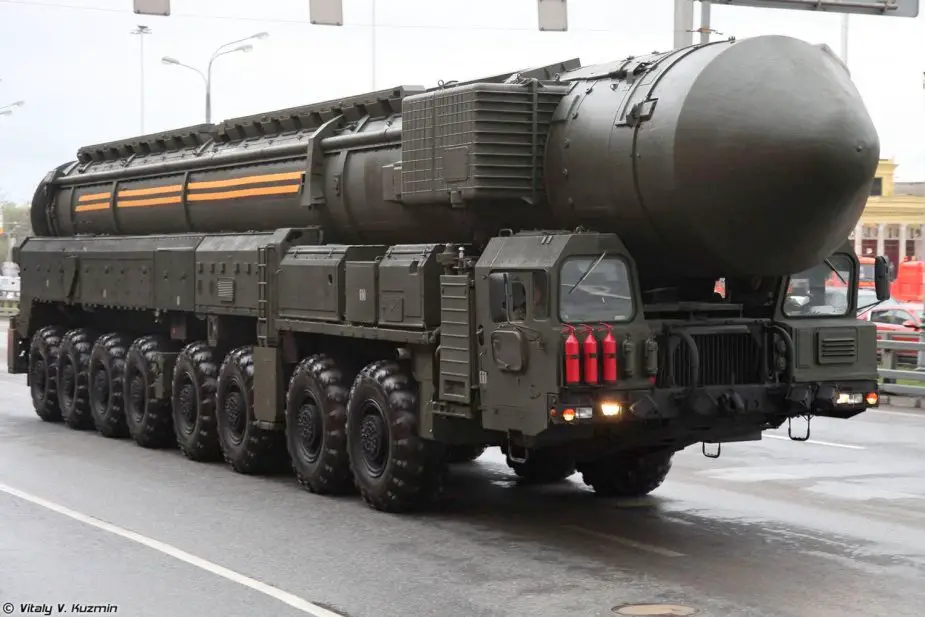Characteristics of Sarmat RS-28 intercontinental ballistic missile (ICBM) were made public at Army-2019 forum. The new missile is to become operational in the coming years and will replace Voevoda RS-20V (R-36M2) with time, the Izvestia daily writes.

RS-28 Sarmat ICBM (Picture source: Vitaly Kuzmin)
The Strategic Missile Forces said Sarmat has a range of 18,000 km and a launch weight of 208.1 tons. The payload weights over 10 tons, on top of 178 tons of fuel. The ICBM is 35.5-meter long with a 3-meter diameter. The characteristics have been discussed before but were for the first time officially presented. "The announced characteristics don’t add anything new to the known data, except for some warhead specifications (single and multiple). It means Sarmat will inherit R-36M2 combat missions," scientific staffer of the Center of International Security of the Institute of World Economy and International Relations Konstantin Bogdanov said.
The most common R-36M2 payload comprises ten reentry vehicles of close to 800 kilotons each in TNT equivalent. Other warheads were designed for the missile, including a single light warhead of 8 megatons and a heavy one of 20 megatons (the latter has not been deployed, according to available information).
Sarmat was designed as Voevoda was ageing. The youngest of them went on combat duty in 1992. START-2 calls to eliminate multi-charge ground-based ICBM, but it did not come into force.
In the early 2010s, media reports said a new heavy ICBM was designed. The news triggered a discussion and the common idea was to develop mostly mobile launchers which are less vulnerable for precision weapons which can strike at silo-based launchers with available coordinates. However, new technologies decreased the prestart preparation of silo-based missiles to several dozen seconds and the high reliability of the ground-based ICBM and their high characteristics and proper design substantiated their development.
In the spring of 2018, President Vladimir Putin announced that Sarmat would soon become operational together with other new weapons. Its range will increase and the ICBM will fly non-standard trajectories along with the usual transpolar one.
The 18,000-km range announced at Army-2019 confirms the characteristics, but also means that Sarmat does not belong to the partially orbital systems of R-36orb type with unlimited range. The issue is only the orbit entry and exit parameters of the reentry vehicle capable of hitting a target in any part of the planet.
As START is close to expiring and there are no visible signs of its prolongation or replacement, Sarmat and other new-generation weapons are doomed to become a bargain. The emergence of new weapons strengthens the Russian positions and provides a basis for talks with the United States and an ability to maneuver. Both parties are likely to observe the ceilings of the treaty due to organizational and financial reasons.
"The deployment of global-range missiles is not restricted by arms control treaties. The deployment of such weapons on combat duty is hardly stabilizing despite the philosophy of reciprocal vulnerability through the creation of new opportunities to break through missile defense. However, global Sarmat will not create major problems for the strategic balance. A small group of such missiles will be the first bargain at negotiations like it happened with R-36orb in 1979," Bogdanov said.
Media leaks are likely in the coming years about various prospective arms of both parties. Russian and US experts will work to determine potential positions in a new bargain which will definitely resume. Regardless of the talks which have yet to begin, deployment of new weapons will continue. "The option of gradual replacement of R-36M2 is likely. The balance and ceilings of ground-based ICBM will change only depending on the state of the START and the general strategic situation, as it is happening now. Sarmat modification will provide an additional dimension, as will carry gliding warheads. But it is a midterm prospect and the number of such missiles will be small," Bogdanov said.
It is difficult to predict the image of a nuclear parity between Russia and the United States in current conditions when both parties seem to have lost the ability to hear each other. But sharp steps are unlikely on both sides, as the world is entering an unknown era of the total absence of any rules in which radical decisions can be only detrimental.
The increase of new strategic offensive arms, including Sarmat, is likely to progress at a slow pace and demonstrate a potential growth of the attack potential rather than truly implement it, the Izvestia said.
© Copyright 2019 TASS / Army Recognition Group SPRL. All rights reserved. This material may not be published, broadcast, rewritten or redistributed.














